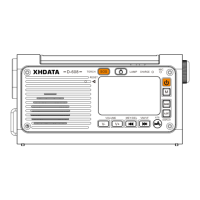
Do you have a question about the XHDATA D-608 and is the answer not in the manual?
Overview of RESET, TORCH/SOS, LOCK/LAMP, CHARGE, MIC functions.
Explains volume adjustment (V-/V+) and power on/off/sleep mode.
Details BAND for band selection and ALERT/DISPLAY for weather/display.
Covers previous/next, VM/VF (scan), and ATS for music and radio.
Explains icons in the power display, such as battery level and status.
Details information shown in the main and secondary display areas, including frequency and status.
Covers battery installation and DC5V charging input for the device.
Describes how to turn the device on and off using the power button.
Setting FM and MW frequency ranges based on regional requirements.
How to switch radio bands (FM, MW, SW, WB) and optimize antenna reception.
Steps for manual (VF) and automatic (ATS) radio scanning.
Procedure to manually search and save desired radio stations.
Using ATS for full band scanning and shortwave meter band search.
Methods to manually or automatically retrieve stored frequencies using VM.
Procedure to select and delete a specific stored radio station from memory.
Steps to remove all saved stations for the current radio band.
Details the 7 WB/NOAA channels and manual search procedure.
How the device scans for weather alerts and provides warnings.
Instructions for activating the SOS button for distress signals.
Instructions for using the flashlight and lamp with brightness adjustments.
How to play MP3 files from a TF card, including navigation.
Information on connecting headphones for stereo audio playback.
Pairing with a phone for music and handling wireless calls.
How to disconnect from a Bluetooth device and then reconnect.
Switching display information and managing screen backlight.
Setting and canceling the sleep timer shutdown mode for device operation.
Step-by-step guide to setting the current time on the device.
How to set the alarm time and adjust its duration.
Setting the alarm source to radio or TF card music.
How to lock and unlock the device's keyboard and tuning button.
Instructions for resetting the system in case of malfunctions or errors.
Standard procedure for charging via USB cable and adapter.
Using solar panels or hand crank for emergency charging.
Using the device's USB output port to charge a mobile phone.
Guidelines for safe handling, charging, and use of the lithium battery.
Specifies radio frequency ranges and noise limit sensitivity.
Information on radio selectivity and maximum number of memory stations.
Specifies the device's maximum audio output power rating.
Covers headphone impedance, speaker, TF card, BT, battery, and input.
Provides contact details and displays relevant certifications (FC, CE).